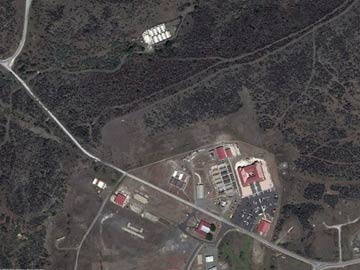
This Sept. 2, 2010 satellite image provided by TerraServer.com and DigitalGlobe shows a portion of Naval Station Guantanamo Bay, Cuba, including the secret facility known as Penny Lane, upper middle in white.
Washington: In the early years after the September 11, 2001 attacks, the CIA turned some Guantanamo Bay prisoners into double agents and then sent them home to help the U.S. kill terrorists, current and former U.S. officials said.
The CIA promised the prisoners freedom, safety for their families and millions of dollars from the agency's secret accounts.
It was a risky gamble. Officials knew there was a chance that some prisoners might quickly spurn their deal and kill Americans.
For the CIA, that was an acceptable risk in a dangerous business. For the American public, which was never told, the program was one of the many secret trade-offs the government made on its behalf. At the same time the government used the risk of terrorism to justify imprisoning people indefinitely, it was releasing dangerous people from prison to work for the CIA.
The program was carried out in a secret facility built a few hundred yards from the administrative offices of the prison in Guantanamo Bay, Cuba. The eight small cottages were hidden behind a ridge covered in thick scrub and cactus.
The program and the handful of men who passed through these cottages had various official CIA code names.
But those who were aware of the cluster of cottages knew it best by its sobriquet: Penny Lane.
It was a nod to the classic Beatles song and a riff on the CIA's other secret facility at Guantanamo Bay, a prison known as Strawberry Fields.
Nearly a dozen current and former U.S officials described aspects of the program to The Associated Press. All spoke on condition of anonymity because they were not authorized to discuss the secret program publicly by name, even though it ended in about 2006.
Some of the men who passed through Penny Lane helped the CIA find and kill many top al-Qaida operatives, U.S. officials said. Others stopped providing useful information and the CIA lost touch with them.
When prisoners began streaming into Guantanamo Bay in January 2002, the CIA recognized it as an unprecedented opportunity to identify sources. That year, 632 detainees arrived at the detention center. The following year 117 more arrived.
"Of course that would be an objective," said Emile Nakhleh, a former top CIA analyst who spent time in 2002 assessing detainees but who did not discuss Penny Lane. "It's the job of intelligence to recruit sources."
By early 2003, Penny Lane was open for business.
Keep reading on NDTV >>
The CIA promised the prisoners freedom, safety for their families and millions of dollars from the agency's secret accounts.
It was a risky gamble. Officials knew there was a chance that some prisoners might quickly spurn their deal and kill Americans.
For the CIA, that was an acceptable risk in a dangerous business. For the American public, which was never told, the program was one of the many secret trade-offs the government made on its behalf. At the same time the government used the risk of terrorism to justify imprisoning people indefinitely, it was releasing dangerous people from prison to work for the CIA.
The program was carried out in a secret facility built a few hundred yards from the administrative offices of the prison in Guantanamo Bay, Cuba. The eight small cottages were hidden behind a ridge covered in thick scrub and cactus.
The program and the handful of men who passed through these cottages had various official CIA code names.
But those who were aware of the cluster of cottages knew it best by its sobriquet: Penny Lane.
It was a nod to the classic Beatles song and a riff on the CIA's other secret facility at Guantanamo Bay, a prison known as Strawberry Fields.
Nearly a dozen current and former U.S officials described aspects of the program to The Associated Press. All spoke on condition of anonymity because they were not authorized to discuss the secret program publicly by name, even though it ended in about 2006.
Some of the men who passed through Penny Lane helped the CIA find and kill many top al-Qaida operatives, U.S. officials said. Others stopped providing useful information and the CIA lost touch with them.
When prisoners began streaming into Guantanamo Bay in January 2002, the CIA recognized it as an unprecedented opportunity to identify sources. That year, 632 detainees arrived at the detention center. The following year 117 more arrived.
"Of course that would be an objective," said Emile Nakhleh, a former top CIA analyst who spent time in 2002 assessing detainees but who did not discuss Penny Lane. "It's the job of intelligence to recruit sources."
By early 2003, Penny Lane was open for business.
No hay comentarios:
Publicar un comentario